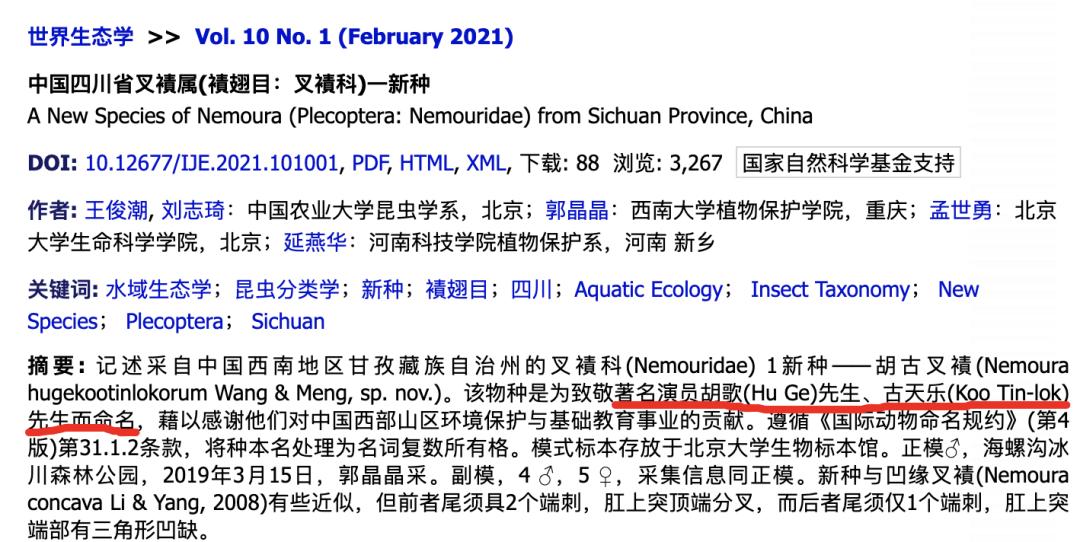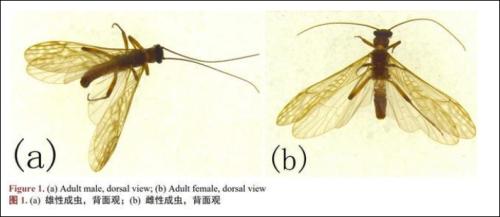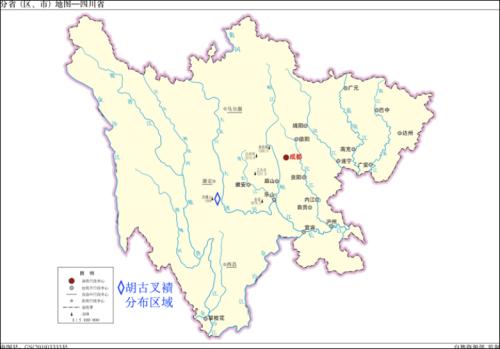Text | Zhang Tiankan
Recently, an academic paper entitled "A new species of Pseudomonas from Sichuan Province, China" has attracted attention both inside and outside the industry. The paper on the new insect species was published in the journal World Ecology. According to the article, the new insect species was collected in Hailuogou Glacier Forest Park in Ganzi Prefecture, Sichuan Province. The author named the insect "Hu Guzha" because, "The species is named in tribute to the famous actors Mr. Hu Ge and Mr. Gu Tianle, to thank them for their contributions to environmental protection and basic education in the mountainous areas of western China."

Naming insects by human names is not an innovation, but this time using the names of celebrities in the entertainment industry has caused a huge controversy. Some professionals believe that there are many things wrong with this academic paper: first, the writing style is weird, and publishing a classification paper in the academic journal "World Ecology" is even more bizarre; secondly, this paper is not like a traditional paper, but more like a scientific essay, which is "showing off literary talent", and there is no need to express emotion in the paper.
It is true that the paper has a fixed writing standard, including format, vocabulary, terminology, etc. However, the writing standard is only a less important one in the evaluation criteria. The essence of the problem is whether the paper follows the academic standard of animal naming, whether it writes (explains) clearly the content, method, process and conclusions of a study, and a rational discussion of the conclusions.

Hugucha
Measured by these two standards, this scientific prose-style paper follows both the standards and does not violate the harmony. The latest edition (4th edition) of the International Code of Zoological Nomenclature, published in 2020, stipulates the principles, grammar, and etiquette norms that zoologists need to abide by in naming species and discussing the naming process of species. According to Article 31.1.2 in this regulation, the author named this insect "Hu Ge" in pinyin of Hu Ge’s name, "Koo Tin-lok" in pinyin of Gu Tianle’s name, and "-orum" in the Latin suffix. Moreover, the paper also explained the entire discovery and research process and results clearly, and discussed the results, which are generally in line with the norms of scientific papers.
Furthermore, both animals and plants can be named by the discoverers according to the taxonomic criteria. These criteria are derived from the biological classification system established by Carl Linnaeus’s "Natural Systems". According to the biological classification standard, the naming of new species must use a unified Latin word and consist of three words.

Huguchan distribution area
The first word is the genus name, which must be named according to scientific classification and cannot be changed casually; the second word is the species name, which can be named after all things; the third word is the surname of the namer. Therefore, it is extremely common to name insects by human names. For example, the British Navy named a bird-wing butterfly in the Pacific Ocean "Queen Victoria’s Winged Butterfly". Moreover, scholars in the United States have discovered more than 200 kinds of insects, named after their relatives and friends.
Why is this generally standard paper so controversial? The reason is that some researchers want to accelerate the integration of science and culture, while others believe that academia is academic, and should not be mixed with cultural, social and other factors. This conflict between science and humanities was proposed by the British writer Charles Percy Snow in his May 7, 1959 Red Lecture on "Two Cultures and the Scientific Revolution" at the University of Cambridge. After decades of discussion and reflection, in 1995, John Brockman’s "The Third Culture" proposed that there is another culture besides the humanities and sciences, which is the third culture where the two are integrated. The core of this culture is that cutting-edge scientists and thinkers should express their ideas and research findings in accessible language, breaking down the cultural divide between pure humanities and sciences, and making their findings accessible to ordinary people.

In other words, researchers should explain and explain their research results through easy-to-understand language and methods, and carry out scientific communication, so that more people can understand and understand the content, principles, and laws of science, so as to benefit the whole society. Separate lines are like mountains, obviously, this is a relatively difficult task. Therefore, there is a huge controversy over the research of "Hugucha" insects.
However, the author of the article expressed the idea of understanding and practicing the third culture. He pointed out that it is not necessary to explain so much research background in the usual entomology papers. The reason why he deliberately wrote in too much detail is that "the main reason is to take into account the readers of the society and avoid public misunderstandings in advance. Instead, it has caused some professionals to misunderstand from another angle."

The factor that allows more people to understand their papers and intentionally introduce culture is the way some researchers currently use. In addition to using literary language, they also intentionally use literary methods to illustrate science, so as to achieve the goal of science and art breaking up at the foot of the mountain and meeting teachers at the top of the mountain. Of course, it can also make more people understand science.
As one of the leading scientific journals in the world, the British journal "Nature" launched a "Future" column on November 4, 1999 (the magazine’s 130th birthday), dedicated to publishing "fun" short science fiction stories. This is a very unusual out-of-the-loop approach, which is far from reality, reason and law. Of course, this approach of Nature magazine is also seen as an attempt to combine science and culture in a third culture.
Scientific papers naming insects and animals after people, as well as expressing scientific content and results in literary and artistic ways, are all worth trying, but there are also areas for discussion, such as how to do it and to what extent it will be more balanced.
The original title: "Naming insects after Hu Ge and Gu Tianle is an attempt"
Read the original text
关于作者